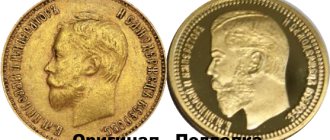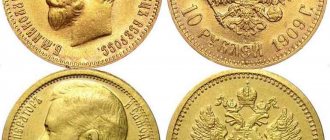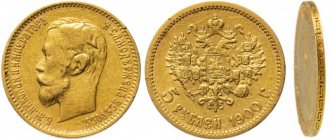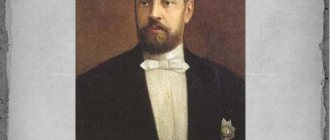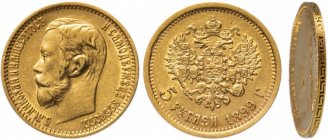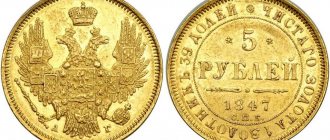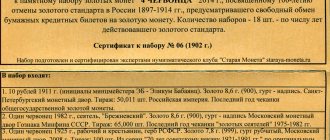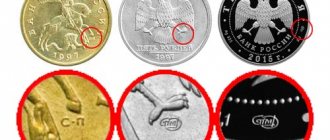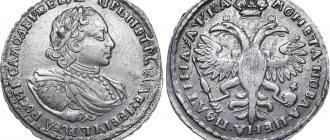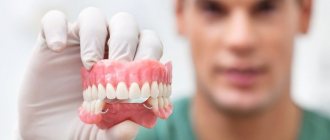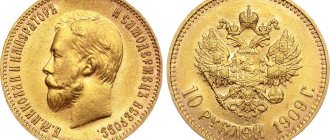Gold coins from the time of Nicholas 2 are perhaps the most common of all coins of the Tsarist era; a huge number of them have survived to this day. This happened for two reasons:
- firstly, they were minted in tens of millions of copies;
- secondly, the imperial 10 and 5 ruble rubles did not last long, and in the Soviet years many generations of Russian people saved them for what is called “for a rainy day,” rightly believing that gold at any time would be “eternal value.”
Without touching on the trial and rare gift coins, such as imperials or 25-ruble coins, we can distinguish only 4 denominations:
- 5 rubles.
- 7 rubles 50 kopecks.
- 10 rubles
- 15 rubles.
7 rubles 50 kopecks and 15 rubles were minted only one year - 1897, and were “transitional” from the old type of coins to the new: Witte’s monetary reform, which began in 1897, involved a transition to the updated format of the ten-ruble note, which was one and a half times lighter than its predecessor from the time of Alexander 3 .
5 and 10 rubles of a new type, weighing 4.3 grams. and 8.6 g. 900 samples, respectively, subsequently became the main gold monetary unit and ensured not only the stable circulation of paper money throughout the Russian Empire, but also strong economic growth.
Tsar's chervonets
The Tsar's chervonets is the slang name for 10 rubles of Nicholas 2; numismatists mean the same thing when they talk about Nicholas's chervonets. This coin was minted during the reign of Nicholas 2 in the years from 1897 to 1911 with short breaks. The price of 10 rubles of Nicholas 2 depends on the minting circulation in each of the indicated years and on the varieties within one year. This gold coin has a standard weight of 8.6 grams of 900 gold. Technological and everyday (from handling) deviation in weight can be observed up to one tenth of a gram; any more serious deviation in weight is a reason to doubt its authenticity. Chervonets are probably the most popular coin among beginning numismatists, as numismatic practice shows. If collectors with many years of experience are interested in such coins, then only in exceptional (unique) preservation.
Lifestyle, habits, hobbies of the Emperor
Most of the time, Nicholas II lived with his family in the Alexander Palace (Tsarskoe Selo) or Peterhof. In the summer I vacationed in Crimea at the Livadia Palace. For recreation, he also annually made two-week trips around the Gulf of Finland and the Baltic Sea on the yacht “Standart”. I read both light entertainment literature and serious scientific works, often on historical topics, Russian and foreign newspapers and magazines. I smoked cigarettes. He was interested in photography and also loved watching movies. In the 1900s, he became interested in the then new type of transport - cars (“the Tsar had one of the most extensive car parks in Europe”).
The official government press in 1913, in an essay about the everyday and family side of the emperor’s life, wrote, in particular: “The Emperor does not like so-called secular pleasures. His favorite pastime is the hereditary passion of the Russian Tsars - hunting. The emperor had a habit of shooting at cats and dogs in his spare time. As a child, he shot them with a slingshot, but as he grew older, he began to do it with a gun. At the age of 9 he began keeping a diary. The archive contains 50 voluminous notebooks - the original diary for the years 1882-1918; some of them were published.
What is the price of the golden chervonets of Nicholas II?
The cost of 10 rubles of Nicholas 2 is directly related to the price of gold on the commodity exchange and for coins minted in the years with the largest circulations and average condition from F (fine) to Au (about uncirculated), the relationship is direct and linear, the more expensive the gold on the exchange, the more expensive the cost of a chervonets with an addition (premium) to the cost of approximately 1 to 5% (depending on other poorly predictable factors such as the balance of supply and demand) to the price of exchange gold. Therefore, the cost of 10 gold rubles of Nicholas 2 in average condition and a “simple” (large circulation) year * can always be determined using the following formula: (gold price per gram on the exchange) * 0.9 (this is the fineness coefficient of the metal in the coin, our 900 fineness )*8.6 (this is the weight of our copy) + 1-5% (numismatic increase, since we are still talking about a coin, albeit of average condition and a huge circulation)*8.6 (this is the weight of our gold chervonets) = the cost of our golden chervonets
*valid for circulations of 1899,1900,1901,1902 with rare exceptions within the framework of rare varieties of each year
Thus, if you are faced with the task of selling Nicholas’s golden chervonets, then you can rely on this simple calculation. Let me remind you: this is the minimum price for a Nikolaev chervonets in average condition and the simplest in circulation (1899,1900,1901,1902). All other years and conditions above AU (about uncirculated) will be at a premium to the indicated price. What could be the increase? This is a question that requires a substantive consideration of each specific instance and the experience of an expert’s assessment. If the task arises of buying 10 rubles for Nicholas 2, then the above calculation can also be a guideline, if you add 10 percent to it. As a rule, you can meet this purchase price.
Coins of Nicholas II Alexandrovich (1894-1917)
The reign of Nicholas II went down in history as a very turbulent period. The revolutionary movements that originated under Alexander III gained strength until they led to the Revolution of 1905. This time the uprising was suppressed. To avoid new unrest, several reforms were adopted regarding freedom of religion, freedom of speech and the establishment of the State Duma. But all this only contributed to the strengthening of popular movements. In 1914, new interstate alliances led to Russia's entry into the First World War. The opposition took advantage of the weakening of the economy and power, and at the beginning of 1917 the February Revolution took place, during which Nicholas II abdicated the throne. In March, the Provisional Government came to power. A year and a half later, in July 1918, the emperor was shot in Yekaterinburg along with his family. There were also many changes in the coinage of this time. In 1895-1898, a monetary reform was carried out under the leadership of S.Yu. Witte, during which the gold ruble became the basis of monetary circulation (before that, silver was considered the main one). The weight of gold coins is reduced by one and a half times. In 1897, coins of the old weight were minted for the last time, but with an increased denomination (15 and 7.5 rubles). In 1915-1916, due to the difficult economic situation, it was planned to introduce lightweight copper-nickel coins in denominations from 3 to 25 kopecks; lower denominations were to remain copper, but one and a half times lighter. The issue of introducing steel money was even considered. All developed versions remained trial ones and are now highly valued among collectors.
15 and 7.5 rubles
Monetary reform S.Yu. Witte meant reducing the weight of gold coins by one and a half times. Experiments with the development of new monetary units (imperial and rus) were not successful; the imperial remained a counting concept equal to 15, and not 10 rubles as before. To simplify calculations and prepare the population for the new money, in 1897, coins of non-standard denominations of 15 and 7.5 rubles were issued in multi-million circulations. 15 rubles has two varieties, differing in the displacement of the inscription relative to the portrait.
10 rubles
Perhaps the most famous gold coin of the Russian Empire, with a portrait of Nicholas II and a coat of arms on the reverse side with a face value of 10 rubles, became one of the symbols of autocracy. A huge number of them were issued, so these coins became the main item for treasures from the Civil War. It was minted annually from 1898 to 1904, then in 1906, 1909, 1910 and 1911. According to unofficial information, they could have been produced in the 1920s for international payments.
5 rubles
Gold 5 rubles with a portrait of Nicholas II and a double-headed eagle were minted from 1898 to 1911, except for 1905 and 1908. The 1907 coins are of great value due to a very limited mintage (a little over 100 pieces). There is a pattern on the edge, with the exception of some issues with a smooth edge. The neck trim contains the engraver's initials.
Ruble
Rubles, like other large silver coins, under Nicholas II had the same design, weight and fineness as under Alexander III, but with a portrait of the new emperor. Minted annually from 1895 to 1915. Before 1902 and in 1913 they had several variants, differing in the designations on the edge. Among the issues of 1896-1899 there are examples of foreign coinage with one and two stars, or with ticks.
50 kopecks
50-kopeck coins of the Nikolaev era had the same design as rubles: a portrait of Nicholas II in profile on one side, the coat of arms and denomination on the other. They were minted every year except 1905. Onets of 1896-1899 were issued not only in St. Petersburg, but also abroad; these have markings in the form of stars or birds on the edge instead of the initials of the mintzmeister.
25 kopecks
Coins of 25 kopecks were minted only in 1895-1896, 1898, 1900 and 1901 without any differences. They had a design identical to rubles and fifty-kopeck notes of that time: a portrait of the emperor in profile, a coat of arms on the other side.
20 kopecks
Since 1901, the production of 20-kopeck coins of the 1867 model from bilon (500 standard) silver has been resumed. Their minting continued until the beginning of 1917. In addition to the designation of the mint, the coins bear the initials of the mintmaster - FZ, AR, EB and BC. Since 1915, the designation of the mint (the letters SPB) has been absent.
15 kopecks
Coins in denomination of 15 kopecks were issued from 1896 to the beginning of 1917, except for 1910, according to the 1867 model. Some copies with the date “1916” were minted at the Osaka Mint (Japan); they do not have the initials of the mintmaster under the eagle. Since 1915, the designation of the mint (the letters SPB) has been absent.
10 kopecks
Issued annually in 1895-1917 according to the 1867 model from 500 silver, coin weight - 1.8 grams. Under the eagle are the initials of the mintzmeister: the letters AG, EB, FZ, AR and BC. Since 1915, the designation of the mint (the letters SPB) has been absent. Some copies with the date “1916” were minted at the Osaka Mint (Japan), they do not have the initials of the mintmaster under the eagle.
5 kopecks
Silver nickels weighing 0.9 grams of the 1867 sample under Nicholas II were minted from 1897 to 1915, except for 1907. Copper coins of this denomination exist only with the dates “1911”, “1912” (letters “SPB”) and “1916”, “ 1917" (without letters), they are made according to the 1867 model.
3 kopecks
During the reign of Nicholas II, the appearance of 3-kopeck coins did not change; their production was resumed in 1895 and continued until the beginning of 1917. Coins with the dates 1915-1917 do not have the letters “SPB” indicating the place of minting.
2 kopecks
2-kopeck coins were minted every year from 1895 to 1917, until 1915 they were marked with the mint designation (the letters “SPB”). The appearance of the coins has not changed since the time of Alexander II.
1 kopeck
Kopecks were minted annually from 1895 to 1917; their design has not changed since the time of Alexander II. In 1915-1917, the mint designation was not given.
1/2 kopeck
Half-kopeck coins with the monogram of Nicholas II were issued in 1894-1900 and in 1908-1916, until 1915 they were marked with the mint mark. Among the coins of 1895 there is a rare monogram variant, which has three petals in the upper curls of the letter “H”.
1/4 kopeck
The smallest denomination of a quarter of a kopeck under Nicholas II was minted in 1894-1900, 1909-1910 (with the letters “SPB”) and in 1915-1916 (without the letters “SPB”).
Imperials and semi-imperials
Towards monetary reform S.Yu. Witte, which was supposed to reduce the weight of gold coins by one and a half times, special coins were developed with denominations in imperials and semi-imperials, on which the denomination in pre-reform gold rubles was duplicated.
Trial Issues
At the end of the 19th century, in response to the ongoing monetary reform, new coins were developed with denominations in imperials and russ; 1 rus was supposed to be equal to 1 new gold ruble. Denominations of 5, 10 and 15 russ are known. In 1911 and 1916, entire series of test coins were made from a copper-nickel alloy in denominations of 25, 20, 10 and 5 kopecks, as well as copper coins in denominations of 5, 3, 2 and 1 kopeck. Others differ only in the shape and size of the portrait.
Catalogs
→
Coins
→
Russian empire
If you notice any inaccuracies, write about it here: “Book of Comments and Suggestions.”
Counterfeits of royal chervonets
10 rubles of Nicholas II are counterfeited, like many coins of the Tsarist period. Typically, copies have a smaller purity (this is the economic sense of counterfeiting ordinary chervonets), which is reflected in the overall dimensions of the coin, since by reducing the purity and in order to comply with the standard weight of 8.6 grams, it will be necessary to fill a larger volume of the intended coin with metal, since most of the available metals lighter than gold. Of course, you can do some of the checks yourself, but the best way to avoid situations with counterfeits is to carefully choose a consultant or coin seller, while having knowledge that will partially allow you to understand what is being checked and how. It should be noted that not often, but there are fakes in which the approximate fineness and dimensional characteristics of the original coins are observed. By purchasing such a coin, you will receive an item that will actually sell on the market for 10-15% less than the metal in it - this is actually selling a copy as a piece of metal, with a discount from the exchange price of gold, which, as a rule, pawnshops take in that or in another form, if they come across a product (genuine coin) that is not stamped (jewelry) or has not left the mint, which (genuine coin) has also been formally tested (by manufacturing technology at the mint).
History of appearance
The first 5 gold rubles were minted back in Elizabethan times, however, it was rather a sign of royal favor for special services to the fatherland. Since then, this denomination has been issued by every emperor up to Nicholas II.
The beginning of the reign of Nicholas II was marked by a number of key reforms. First of all, the changes affected monetary circulation. The gold standard was introduced and the ruble was devalued, which also affected the 5 ruble denomination. In the first two years after Nicholas II came to power (1895-1896), so-called semi-imperials were issued.
After devaluation, the banknote lost a third of its value and its pompous name, becoming simply a five-ruble note.
Witte's monetary reform of 1897
This reform was carried out by Emperor Nicholas II in 1895–1897. This was prepared under Alexander II and Alexander III, but it was carried out fully and thoughtfully under the last Russian emperor. She established the gold standard of the ruble and brought it to the level of a world currency. New coins have appeared in denominations of 15 rubles and 7 rubles 50 kopecks. The reform was carried out by the Minister of Finance S.Yu. Witte and made it possible to significantly improve the state of the economy in the country. Historians, having analyzed many reforms, consider it one of the most successful in the history of the tsarist state. Thanks to the strengthened position of the Russian Empire on the world stage, the reform was carefully prepared and thought through. It took place in several stages and lasted for several years. It is likely that if Russia had not been drawn into World War I, it would have become a leading world power with a strong economy, a stable ruble and advanced monetary policy.
How much is the silver coin Nicholas 2 worth?
| Denomination | Production year | Price in rubles* |
| Pyatak | 1897–1905, 1907–1909, 19011-1915 | 500–800 |
| 1906 | 1800 | |
| 1910 | 1200 | |
| Dime | 1898–1916 | 150–250 |
| 1895 | 3 000 | |
| 1896–1897 | 1 000 | |
| 1916 (Osaka) | 1500 | |
| 1917 | 5000 | |
| 15 kopecks | 1899–1916 | 200–250 |
| 1896 | 10 000 | |
| 1897–1898,1916 | 1 000–1 500 | |
| 1917 | 6 000 | |
| 20 k. | 1901–1916 | 250–800 |
| 1917 | 35 000 | |
| 25 k. | 1895–1896 | 1 200-3 000 |
| 1900 | 4 500 | |
| 1901 | 45 000 | |
| 50 k. | 1895–1897, 1899–1901, 1910–1914 | 400 |
| 1898 | 100 000 | |
| 1902, 1908–1914 | 700-1 500 | |
| 1903 | 5 000–9 000 | |
| 1 ruble | 1895–1901 | 700 |
| 1902–1903, 1906–1915 | 3 000–5 000 | |
| 1904–1905 | 10 000–12 000 |
*The table shows the initial auction price for valuable coins of Nicholas 2. The price range can be tenfold or higher.
For example, for 20 silver kopecks you can get 2,500 rubles. (according to the catalogue, it starts from 250 rubles)
Varieties of coins
In addition to the year of minting and mintmaster initials, there are banknotes made of gold with a smooth edge or an irregular (coaxial) arrangement of the reverse and obverse.
Expert opinion
Alexander Ivanovich
Private collector with 4500+ coins and bonds in his personal collection. Knows the value of each of them today.
All these types of money of Nicholas II are a manufacturing defect. But it is precisely such copies, due to their exceptional rarity, that have a special collector’s value, and their price is several orders of magnitude higher than other varieties of the circulation.
Relief and smooth edge
Side alignment 180°
Appearance and Design
The design of the gold coin for Nicholas II was developed by Anton Fedorovich Vasyutinsky, who at that time held the post of chief medalist of the St. Petersburg Mint. The master’s outstanding talent allowed him to create a true work of art - gold coins made according to his sketches are still among the most beautiful examples of numismatics.
Obverse
On the front side of the gold sample there is a stamp of a profile portrait of Emperor Nicholas II, the inscription “BM Nicholas II Emperor and Autocrat of All Russia.” in the form of two hemispheres surrounds the portrait, edging along the edge in the form of a patterned rim.
Reverse
On the reverse side there is an image of the so-called small official emblem of the state - a double-headed eagle under the shadow of three crowns. He holds the attributes of royal power (orb and scepter). On the chest there is a shield with St. George the Victorious, on the wings - with the coats of arms of the eight kingdoms that were part of the empire. The face value and year of minting are indicated at the bottom.
edge
An abstract ornament is stamped on the edge and in brackets the initials of the official who, at the time of minting gold, held the post of mintmeister (manager) of the state mint.
